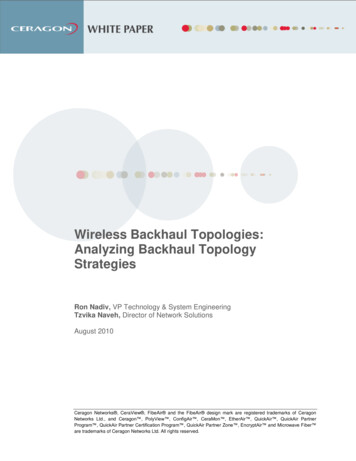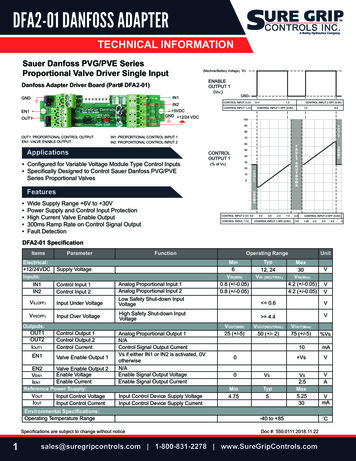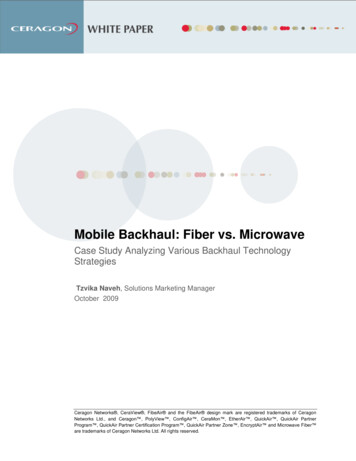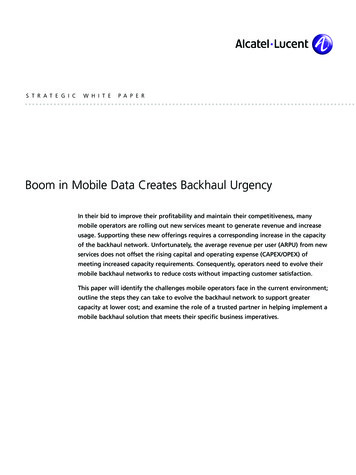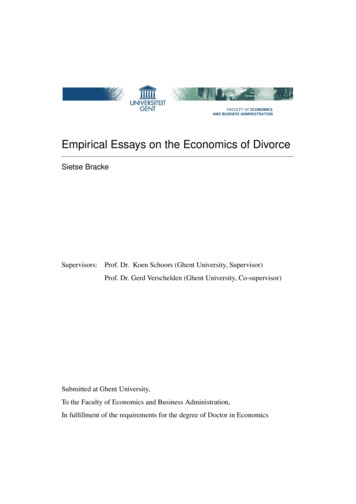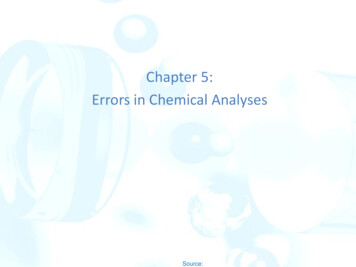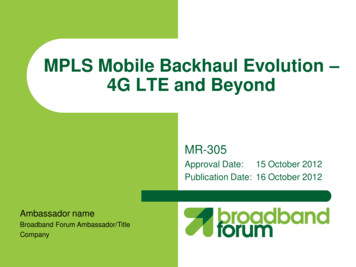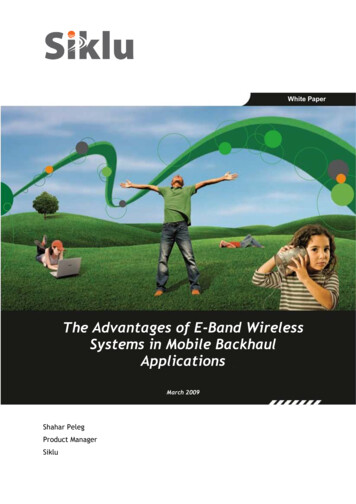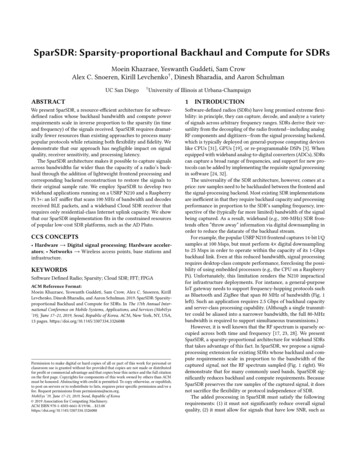
Transcription
SparSDR: Sparsity-proportional Backhaul and Compute for SDRsMoein Khazraee, Yeswanth Guddeti, Sam CrowAlex C. Snoeren, Kirill Levchenko† , Dinesh Bharadia, and Aaron SchulmanUC San Diego† Universityof Illinois at Urbana-ChampaignABSTRACT1We present SparSDR, a resource-efficient architecture for softwaredefined radios whose backhaul bandwidth and compute powerrequirements scale in inverse proportion to the sparsity (in timeand frequency) of the signals received. SparSDR requires dramatically fewer resources than existing approaches to process manypopular protocols while retaining both flexibility and fidelity. Wedemonstrate that our approach has negligible impact on signalquality, receiver sensitivity, and processing latency.The SparSDR architecture makes it possible to capture signalsacross bandwidths far wider than the capacity of a radio’s backhaul through the addition of lightweight frontend processing andcorresponding backend reconstruction to restore the signals totheir original sample rate. We employ SparSDR to develop twowideband applications running on a USRP N210 and a RaspberryPi 3 : an IoT sniffer that scans 100 MHz of bandwidth and decodesreceived BLE packets, and a wideband Cloud SDR receiver thatrequires only residential-class Internet uplink capacity. We showthat our SparSDR implementation fits in the constrained resourcesof popular low-cost SDR platforms, such as the AD Pluto.Software-defined radios (SDRs) have long promised extreme flexibility: in principle, they can capture, decode, and analyze a varietyof signals across arbitrary frequency ranges. SDRs derive their versatility from the decoupling of the radio frontend—including analogRF components and digitizers—from the signal processing backend,which is typically deployed on general-purpose computing deviceslike CPUs [31], GPUs [19], or re-programmable DSPs [3]. Whenequipped with wideband analog-to-digital converters (ADCs), SDRscan capture a broad range of frequencies, and support for new protocols can be added by implementing the requisite signal processingin software [24, 32].The universality of the SDR architecture, however, comes at aprice: raw samples need to be backhauled between the frontend andthe signal-processing backend. Most existing SDR implementationsare inefficient in that they require backhaul capacity and processingperformance in proportion to the SDR’s sampling frequency, irrespective of the (typically far more limited) bandwidth of the signalbeing captured. As a result, wideband (e.g., 100-MHz) SDR frontends often “throw away” information via digital downsampling inorder to reduce the datarate of the backhaul stream.For example, the popular USRP N210 frontend captures 14-bit I/Qsamples at 100 Msps, but must perform 4 digital downsamplingto 25 Msps in order to operate within the capacity of its 1-Gbpsbackhaul link. Even at this reduced bandwidth, signal processingrequires desktop-class compute performance, foreclosing the possibility of using embedded processors (e.g., the CPU on a RaspberryPi). Unfortunately, this limitation renders the N210 impracticalfor infrastructure deployments. For instance, a general-purposeIoT gateway needs to support frequency-hopping protocols suchas Bluetooth and ZigBee that span 80 MHz of bandwidth (Fig. 1left). Such an application requires 2.5 Gbps of backhaul capacityand server-class processing capability. (Although a single transmitter could be aliased into a narrower bandwidth, the full 80-MHzbandwidth is required to support simultaneous transmissions.)However, it is well known that the RF spectrum is sparsely occupied across both time and frequency [17, 23, 28]. We presentSparSDR, a sparsity-proportional architecture for wideband SDRsthat takes advantage of this fact. In SparSDR, we propose a signalprocessing extension for existing SDRs whose backhaul and compute requirements scale in proportion to the bandwidth of thecaptured signal, not the RF spectrum sampled (Fig. 1 right). Wedemonstrate that for many commonly used bands, SparSDR significantly reduces backhaul and compute requirements. BecauseSparSDR preserves the raw samples of the captured signal, it doesnot sacrifice the flexibility or protocol independence of SDR.The added processing in SparSDR must satisfy the followingrequirements: (1) it must not significantly reduce overall signalquality, (2) it must allow for signals that have low SNR, such asCCS CONCEPTS Hardware Digital signal processing; Hardware accelerators; Networks Wireless access points, base stations andinfrastructure.KEYWORDSSoftware Defined Radio; Sparsity; Cloud SDR; FFT; FPGAACM Reference Format:Moein Khazraee, Yeswanth Guddeti, Sam Crow, Alex C. Snoeren, KirillLevchenko, Dinesh Bharadia, and Aaron Schulman. 2019. SparSDR: Sparsityproportional Backhaul and Compute for SDRs. In The 17th Annual International Conference on Mobile Systems, Applications, and Services (MobiSys’19), June 17–21, 2019, Seoul, Republic of Korea. ACM, New York, NY, USA,13 pages. https://doi.org/10.1145/3307334.3326088Permission to make digital or hard copies of all or part of this work for personal orclassroom use is granted without fee provided that copies are not made or distributedfor profit or commercial advantage and that copies bear this notice and the full citationon the first page. Copyrights for components of this work owned by others than ACMmust be honored. Abstracting with credit is permitted. To copy otherwise, or republish,to post on servers or to redistribute to lists, requires prior specific permission and/or afee. Request permissions from permissions@acm.org.MobiSys ’19, June 17–21, 2019, Seoul, Republic of Korea 2019 Association for Computing Machinery.ACM ISBN 978-1-4503-6661-8/19/06. . . UCTION
100 MHzWiFiCh 120 MHzBTCh 15ZBCh 262 MHz (each)Full-capture SDRFreq/time selective capturebackhaul bandwidth in residential networks has traditionally forcedcrowd-sourced SDRs to operate with only narrowband (3.2-MHz)USB SDR dongles [25, 29]. Finally, we demonstrate that batterypowered wideband SDRs have sufficient processing resources toincorporate SparSDR’s additional stages, including the USRP E310and USB-powered SDRs such as the AD Pluto and USRP B210.In summary, our contributions are as follows:(1) We describe how the STFT can be employed as a lightweightfrequency/time-selective downsampling algorithm that produces protocol-independent raw samples that requires backhaul proportional to the bandwidth of the captured signal.We also present a lightweight time-domain reconstructionalgorithm which uses partial STFTs to downsample to theprimary signals in a capture (Section 3).(2) We evaluate the tradeoffs associated with STFT-based downsampling and demonstrate that the resource-constrainedUSRP N210—and even the 100 AD Pluto—have sufficientunused resources to support SparSDR (Section 4).(3) We evaluate SparSDR in two case studies: an IoT gatewaybuilt using a USRP N210 connected to a Raspberry Pi, and awideband Cloud SDR that operates over residential Internetclass backhaul links (Section 6).100 MHzSparsity-proportional SDRFigure 1: SparSDR’s goal is to make SDRs capture primary transmissions rather than entire channels.below-the-noise transmissions from IoT protocols, and (3) it mustfit in the unused processing resources of existing SDR computeplatforms. We satisfy all three of these constraints by repurposinga classic signal analysis technique, short-time Fourier transform(STFT) [13, 33]. STFT is traditionally used for power-spectrumanalysis: observing the primary frequency components that exist ina signal, and how they change over time. The key property of STFTthat makes it possible to achieve sparsity proportionality is thatonly the primary frequency components need to be backhauled toreverse the transform and recover the raw samples.Although STFT is reversible, existing algorithms generally recreate the entire raw sample stream—hence, while the backhaul requirements may be reduced, the signal processing task remainsproportional to the original sample rate, not the bandwidth ofprimary signals in the capture. In SparSDR, we introduce a sparsityproportional reconstruction algorithm that recovers only a portionof the captured signal. Specifically, it reverses only part of the STFT,effectively using STFT itself to identify and isolate the primarysignals. The algorithm also corrects for the phase and frequencyoffsets introduced by STFT-based downsampling.In this paper, we evaluate the tradeoffs in the parametrizationof STFT-based downsampling; the size of the FFT and the typeof window used can both significantly impact the downsamplingsize, signal quality, and latency. We find that by applying a simplethreshold to detect primary signals, it is possible to detect signalsbelow the noise floor. We also demonstrate that STFT fits in the unused processing resources of current SDR frontends. Therefore, byreplacing the downsampling found in existing SDRs with STFT, wecan backhaul and process signals with bandwidth and performancerequirements inversely proportional to the sparsity of the signals.Using SparSDR, we demonstrate that a USRP N210 can can continuously capture 100 MHz while sending 14-bit I/Q samples—4 its backhaul capacity. Specifically, we show that it is possible tosimultaneously receive 450 Bluetooth Low Energy (BLE) transmissions per second across the full 2.4-GHz band using a Raspberry Pi3 connected to a SparSDR-enabled USRP N210 operating at its full100-MHz bandwidth. We also show that SparSDR makes it possibleto build a Cloud SDR platform out of low-end wideband SDRs (e.g.,an Analog Devices Pluto), residential-class backhaul, and inexpensive computing platforms (i.e., the Raspberry Pi 3 ). The limitedSparSDR is open source. We have developed a SparSDR modulefor GNU Radio, making it easy to drop into existing projects. Thehardware implementation is parametrized to enable porting to newSDR platforms (Section 5); we provide example hardware implementations for the USRP N210 and AD Pluto. The hardware andsoftware source can be found NIn this section, we motivate the need for frequency and time sparsityproportional SDRs. First, we provide an example of how widebandSDR captures are sparse in frequency and time. Then, we describehow simple downsampling in today’s SDRs selects only one contiguous band at a time—indiscriminately throwing away signals—andleaves many spare processing resources.2.1Popular bands are sparsely occupiedThe motivation for SparSDR comes from the observation that thereis a mismatch between the sparsity of spectrum usage and the fullcapture design of SDRs. Commodity SDR RF frontends are oftenbuilt with wide-band ADCs that can capture more than 50 MHz,making it possible for them to capture many channels and protocolssimultaneously. In the following experiment, we demonstrate thatthe popular 100-MHz wide 2.4-GHz ISM band is sparsely occupied—even though it is shared by a variety of protocols such as WiFi (threeorthogonal 20-MHz channels), Bluetooth (79 1-MHz channels), andZigBee (sixteen 2-MHz channels).We use the OneRadio1 wideband SDR to capture a 45-second125-MHz bandwidth snapshot of the entire 2.4-GHz band in an office building during business hours. Fig. 2 shows a 150-millisecondportion of the capture. Even in this short period, it is evident thatalthough the 2.4-GHz band is active (there are WiFi packets being1 nology
10.8CDF0.60.40.20020406080100120Instantaneous BW (MHz) measured every 10 usecFigure 2: A snapshot of the 2.4-GHz band collected by a OneRadio wideband (125-MHz) SDR shows that even popular unlicensedbands are sparsely occupied.transmitted), its usage is sparse in frequency and time. Fig. 3 showsthe distribution of instantaneous bandwidth occupancy every 10 microseconds across the entire 45-second capture. This figure showsthat the wide-band (125-MHz) capture is sparse: the band is unoccupied for almost 40% of the time and the occupancy is less than18 MHz (approximately one WiFi channel) 85% of the time.2.2SDRs need smarter downsamplingSDR frontends often downsample to reduce the capture bandwidthto allow for the use of inexpensive and widely available backhaullinks. These inexpensive links limit the capture bandwidth: theUSRP N210 can only capture 25 Msps on its gigabit-Ethernet backhaul, and the AD Pluto can only achieve 5 Msps over its USB 2.0backhaul (with four bytes per I/Q sample). Downsampling is alsonecessary to operate within the compute resources available. Forinstance, processing a 100-Msps capture on a desktop-class 3-GHzCPU only allows for 30 cycles per sample and is simply infeasible on an inexpensive embedded processor like that found on theRaspberry Pi.This is an unfortunate state of affairs, because many signalsare indiscriminately thrown away during downsampling. However,the fact that the downsampling logic is often implemented on anFPGA at the SDR frontend presents an opportunity to modify thefrontend to downsample more intelligently. Many SDR frontendshave additional processing resources intended to support smarterdownsampling, the implementation must be compact in order to fitinto the FPGAs of existing SDRs.3DESIGNSparSDR is an add-on for existing software-defined radios, shownin Fig. 4, that makes them sparsity-proportional: they only requirebackhaul capacity and compute resources in inverse proportion tothe sparsity of the signals they receive. The primary component ofSparSDR is a frequency-and-time selective downsampling step thatreplaces the basic downsampling logic in the SDR frontend. Withthis modification, the SDR frontend only backhauls samples at frequencies that have active signals. To support frequency-and-timeselective downsampling, SparSDR also inserts an extra processingstep to reconstruct the raw time-domain samples at the backendFigure 3: Distribution of occupied bandwidth over 10 microsecondintervals at 2.4 GHz. We use a relative power threshold of 5 dB abovethe maximum observed noise floor to determine if a frequency isoccupied.compute platform (e.g., CPU, GPU, or DSP). We introduce an efficient reconstruction algorithm that recreates the time-domainsignals while maintaining the same level of sparsity. Unlike compressed sensing, SparSDR does not require new frontend hardware(i.e., random sampling ADCs), nor any assumptions regarding thesparsity of the captured signal, and the reconstruction algorithmcan operate within the constrained performance of embedded platforms (e.g., Raspberry Pi).Here we focus exclusively on making the receiver side of SDRssparsity-proportional. SDR receivers are are more computationallyintensive than transmitters: receivers produce a constant stream ofsamples that must be processed in real time. We note, however, thatSparSDR can be modified to operate on the transmit side of SDRs byreversing its steps: The frequency-and-time selective downsamplingalgorithm can be reversed to construct a signal that is sparse in thefrequency domain, and upsample it to the full bandwidth of thetransmit front-end (e.g., DACs). A potential application could be toefficiently transmit multiple, concurrent BLE packets (2 Msps) atvarying frequencies in the 80-MHz ISM band.3.1Frequency-and-time downsamplingWe begin by describing SparSDR’s downsampling algorithm thatgenerates a sample stream whose bandwidth is inversely proportional to the signal sparsity in the captured spectrum. To retainthe flexibility and protocol independence of SDR, SparSDR’s downsampling must be general: it cannot be specific to a particularcommunication protocol.We draw inspiration from a popular spectrum analysis measurement: power spectral density. Typically observed with a spectrumanalyzer, the power spectrum reveals the frequency and magnitudeof received signals. A common tool for performing power spectralanalysis is the Short-Time Fourier Transform (STFT) [33]. STFTdivides the sample stream into overlapping shorter windows ofequal length and then computes the Fourier transform on eachshorter window. This process reveals the frequencies of the signalsthat are active in that short window of time. For instance, we usethe STFT to generate Fig. 2, showing sparse usage of the 2.4-GHzspectrum.
SDR frontendADCDownsamplingSparSDR frontendADCNetworkChannelSelectorNetworkBin selectorNetworkEmbedded processorDATADATAHigh-performance processorDecode perchannelFFTDecodePhase and FreqCorrectionIFFTNetwork(b) Sparsity-proportional SDR (SparSDR)(a) Full-capture SDRFigure 4: (a) Full-capture SDRs require backhaul and compute resources that are equal to the bandwidth of the downsampled ADC capture.(b) SparSDR introduces new blocks that make resource usage proportional to the sparsity of the captured signals.3.2Sparse representation of signals with STFTWe first describe how we parameterize the STFT in SparSDR toproduce a sparse frequency-domain representation of a capturewithout harming signal quality. In particular, we select an STFTwindowing function and determine the overlap between windows.A naive approach, commonly called rectangular windowing,would be to use no windowing function and divide the captureinto non-overlapping short windows of samples. However, rectangular windowing does not produce a sparse representation in thefrequency domain. Fig. 5 shows the frequency response curves ofthe rectangular window compared to other common STFT windowfunctions. The rectangular window leaks energy into adjacent binswith its main lobe at -13db. Due to the sharp transitions at the edges0RectangularHanningHamming-20Amplitude in dBOur key insight is that the STFT algorithm can be repurposedto downsample an SDR frontend’s ADC capture in frequency andtime. We can then detect the frequency bins which are active andbackhaul only those bins. The resulting downsampling is proportional to the activity in spectrum. For example, for the captureshown in Fig. 2 we would backhaul just the few active frequencyand time components during the transmissions. Importantly, STFTis invertible and protocol independent. Even when backhaulingonly the active frequency and time components, we can reconstructthe active signals accurately.A natural question is then: Can we compute STFT-based downsampling in real time on SDR frontends? The STFT transform iscomputed by repeatedly performing an FFT operation on short windows of a capture. The use of FFTs means the STFT computationcan be hardware-accelerated to operate in real time. Specifically,we rely on pipelined streaming FFT hardware implementations thattake in one time-domain sample and output one FFT frequency binper clock cycle. Efficiency improves with increasing FFT (capturewindow) length, but it also increases decoding latency (detailed inSection 5.1). Additional latency may be problematic if a transmitterneeds to respond quickly after receiving a packet (e.g., by sendingan acknowledgment).An effective STFT-based downsampling approach must addressseveral complexities, however, that we discuss below in turn: (1)the FFT must be parameterized to produce a sparse frequencydomain representation of each signal contained in the capture; (2)a detection algorithm is needed to select the active frequency binsto be backhauled; and (3) the frequency bins must be efficientlyreconstructed back into raw samples. We discuss each of theseissues in turn in the remainder of this section.-40-60-80-10005101520BinsFigure 5: Frequency response of common window functionsof the rectangular window, the leakage does not degrade rapidly,even at bins that are far from the center. This leakage negates thebenefits of STFT-based downsampling because the signal’s energyis spread over many frequency bins, each of which would needto be backhauled in SparSDR. Moreover, leakage poses a problemfor signals that are close in frequency which would therefore bemapped to the same STFT bins.In contrast to the rectangular window, generalized cosine windows attenuate the amplitude of the samples at the edges of theSTFT. Fig. 5 plots the frequency response of two common cosinewindows, Hanning and Hamming. The figure shows that cosinewindows can provide sparse representation of signals in the frequency domain by reducing energy leakage into adjacent frequencybins. These window functions are preferable for SparSDR becausethey reduce the number of bins that must be backhauled to reconstruct the signal [27, Ch. 7, p. 468]. For example, Fig. 5 suggests thatSparSDR need only backhaul a few bins adjacent to the signal ifHamming or Hanning windowing functions are employed.Unfortunately, there is a complication with the direct applicationof cosine windows: they significantly attenuate the time-domainsamples at the edges of each window. Simply inverting the windowonly amplifies the noise (quantization) at the edges of each window.We observe, however, that samples at the edges of a cosine windowcan be perfectly recovered by overlapping sequential windows byhalf of the window length (the overlapped region of the sinusoidsadds up to one). While overlapping windows by 50% introduces abandwidth and computation overhead of 2 compared to a nonoverlapping rectangular window, we demonstrate in Section 4.1 the
Main Lobe0Full length IFFT0Magnitude (dB)-10fc0-30fc0TimeDomain-20t0tFigure 7: Compute-efficient reconstruction with partial IFFT-40-50-2-1.5-1-0.500.5Frequency (MHz)11.52Figure 6: An example of SparSDR’s threshold-based energy detectorapplied to an STFT of a Bluetooth signal. Thresholding a Bluetoothsignal results in backhauling at most 10 bins (0.5%) of a 2048-binSTFT for a 100 MHz capture.tradeoff is worthwhile for SparSDR: overlapping cosine windowsprovide more than a 2 reduction in backhaul bandwidth.Compared to the gradual decline in frequency response of theHamming window, we find the Hanning window’s steep decline isbetter-suited for SparSDR. Although the Hamming window has alower first sidelobe, Hanning requires backhauling fewer bins because the energy is concentrated in the closest few bins. Therefore,we select the Hanning window as the default window function forSparSDR. If custom windowing is desired, SparSDR’s software canload new windowing coefficients into the SparSDR frontend FPGA.3.3Partial IFFT (SparSDR)FrequencyDomainSide LobesUniversal signal detection for STFTNext we describe how SparSDR selects the frequency bins in anSTFT that contain signals of interest. A typical approach to detect a signal is to use time-domain correlation, namely searchingfor a protocol-specific synchronization sequence (e.g., a preamble) [25]. We eschew time-domain correlation in SparSDR preciselybecause it requires protocol-specific processing, which would undermine the flexibility of SDR frontends. Time-domain correlationsare not universal: they requires the knowledge of the correlationsequence for each protocol. Said differently, it can only detect signals whose correlation sequences are known a priori. Furthermore,time-domain correlation requires per-protocol processing, makingreal-time multi-protocol frontends hard to implement.Instead, SparSDR uses a threshold-based energy detector, anefficient and universal method of detecting signals. It is universal because it does not depend on any signal-specific patterns,and efficient because it does not require per-protocol computation.SparSDR compares the magnitude of each FFT bin with a threshold. If the magnitude is above the threshold, the bin is backhauled,otherwise the bin is dropped.Fig. 6 shows an example of what SparSDR’s energy-based thresholding looks like for a 1-MHz Bluetooth signal. In this example, wesimulated capturing the Bluetooth with 100 MHz of bandwidth anda 2048-bin STFT. Notice that SparSDR does not need to backhaul theentire 1 MHz Bluetooth signal ( 20 bins). The reason is, Bluetoothis frequency modulated, so each STFT only contains a few symbols.Therefore, SparSDR only needs to backhaul the main lobe and theside lobes for those symbols, which together only occupy only halfof the Bluetooth bandwidth (10 bins).While energy-based signal detection can miss decodable signalsthat are below the noise—such as distant ZigBee transmissions—weobserve that this is mitigated by the natural oversampling SparSDRprovides by performing the STFT on the full capture bandwidth.STFT bins are averaged over many time-domain samples (e.g., 2048)captured at a high sample rate (e.g., 100 Msps) that is several timesfaster than required for ZigBee. We evaluate the benefits of oversampling for energy-based detection in Section 4.3.The thresholds for energy-based signal detection must be setcarefully to avoid detecting spurious signals. A receiver may havenon-uniform noise in the frequency domain, and harmonics fromout-of-band transmitters may alias into the capture bandwidth. Toaddress this issue, SparSDR provides a configurable threshold foreach FFT bin that can be updated constantly as conditions change.To help select bin thresholds, SparSDR monitors the averageenergy of each bin. The monitoring is implemented on the SDRfrontend’s FPGA as an exponentially weighted moving average(EWMA). The benefit of using a weighted average is that it hasa streaming implementation that requires only limited FPGA resources. When a new FFT value is available for bin n, the FPGAupdates the bin average using the following formula:Avд (n) new α · Avд (n)old (1 α ) · V alue (n) .The length of the averaging window (α) is configurable at theSDR backend. A short window is useful for monitoring the noisefloor of a bin that has dynamic transmissions. Such monitoring isuseful in ISM bands, where the noise floor must be distinguishedfrom signals originating from many transmitters that are received atdifferent energy levels. A longer window is effective for determiningif a bin is occupied by a constant transmitter (e.g., TV and radiobroadcasts). Such constant transmissions consume a large amountof backhaul resources and might not be of interest for a particularapplication of SparSDR. To make it possible to ignore these signals,we support a bin-masking feature: masking acts like a notch filterto avoid backhauling specific signals that are not of interest.3.4Efficient reconstruction of partial STFTsThe final component of SparSDR is the efficient reconstruction oftime-domain signals from the frequency-domain STFT bins thatare backhauled to the processing backend. These time-domainsignals need to be recovered at their original sample rate (e.g.,2 Msps for BLE) in order to prepare them for decoding or otherapplication-specific signal processing. To achieve our vision of
Figure 8: Downconverting the frequency-domain bins results in a discontinuity in the time domain.sparsity-proportional compute, this reconstruction step must beefficient: the compute resources required should be proportional tothe data rate of the partial STFTs that are being backhauled.A straightforward approach to reconstruction would be to perform an IFFT that is the same length as the FFT executed on theSDR frontend. This would require performing a full-length IFFTon the bins backhauled from the SDR frontend, with other bins setto zero (Fig. 7 left). The time-domain samples output by this fulllength IFFT must be downconverted to baseband by multiplyingby a sinusoid, and then downsampled from the full capture rateto the signal’s sample rate. Clearly, the amount of processing isindependent of the number of bins backhauled.A more efficient system would directly reconstruct the timedomain samples at (or close to) the desired signal sample rate byperforming an IFFT with a length equal to the number of backhauled frequency-domain bins from an STFT. This approach resultsin a sparsity-proportional reconstruction process as well, wherethe computation required is proportional to the number of activebins. As shown in the right-hand side of Fig. 7, SparSDR, performsan IFFT on only part of the full window length, simultaneouslydownconverting the center frequency of the signal to baseband anddownsampling to an appropriate sample rate.23.5Phase offset compensationIndeed, a partial IFFT can reconstruct the time-domain signal. However, it also introduces a time-domain discontinuity in the signal.The reason is that taking the partial IFFT implicitly downconvertsthe signal to baseband. This change in center frequency createsphase discontinuities at the boundaries of the time-domain windows. To better understand this artifact, consider the example depicted in Fig. 8. A sinusoid at frequency fc is converted to thefrequency domain by an STFT across three windows (top left). Thetime-domain signal after an IFFT is a perfect sinusoid (top right). Ifwe perform a simple downconversion by shifting the bins to thecenter frequency (lower left), changing the frequency introduces aphase discontinuity at each window boundary (lower right).The discontinuity in phase is due to the windowing effects ofthe STFT. Downconverting a signal in the time domain involvesmultiplying the signal by a sinusoid e ( j2π fc ) at the signal’s centerfrequency fc . In the frequency domain, this operation is equivalentto shifting the frequency axis by fc as follows:X ( f fc ) x (t ) e j2π fc t .2 If the frequency offset and sample rate are not an integer multiple of the frequency binspacing, the time-domain samples must be corrected with additional downconversionand downsampling. Fortunately, these corrections do not add significant computationaloverhead because they are performed after the initial STFT-based downsampling.In a windowed FFT, the start time of each segment increments foreach subsequent segment. Therefore, each segment has an additional phase term which is proportional to the time at which thesegment was captured tst ar t and the shift in frequency fc . For eachsegment x k (t ) x (tst ar t (0 : Nf 1 )), the downconversion cansbe computed as:X k ( f
wideband applications running on a USRP N210 and a Raspberry Pi 3 : an IoT sniffer that scans 100 MHz of bandwidth and decodes received BLE packets, and a wideband Cloud SDR receiver that requires only residential-class Internet uplink capacity. We show that our SparSDR implementation fits in the constrained resources
